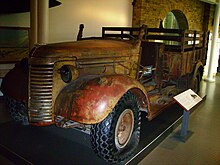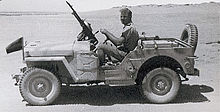Long Range Desert Group
1941 1942 Associated articles The Long Range Desert Group (LRDG) was a reconnaissance and raiding unit of the British Army during the Second World War.
Originally called the Long Range Patrol (LRP), the unit was founded in Egypt in June 1940 by Major Ralph Alger Bagnold, acting under the direction of General Archibald Wavell.
The majority of the men were from New Zealand, but they were soon joined by a few Southern Rhodesian and British volunteers, whereupon new sub-units were formed and the name was changed to the better-known Long Range Desert Group (LRDG).
The LRDG was formed specifically to carry out deep penetration, covert reconnaissance patrols and intelligence missions from behind Italian lines, although they sometimes engaged in combat operations.
During the Desert Campaign between December 1940 and April 1943, the vehicles of the LRDG operated constantly behind the Axis lines, missing a total of only 15 days during the entire period.
[4] Possibly their most notable offensive action was during Operation Caravan, an attack on the town of Barce and its associated airfield, on the night of 13 September 1942.
However, their most vital role was the 'Road Watch', during which they clandestinely monitored traffic on the main road from Tripoli to Benghazi, transmitting the intelligence to British Army Headquarters.
With the surrender of the Axis forces in Tunisia in May 1943, the LRDG changed roles and moved operations to the eastern Mediterranean, carrying out missions in the Greek islands, Italy and the Balkans.
[5] General Wavell was familiar with desert warfare, having been a liaison officer with the Egyptian Expeditionary Force during the First World War,[6] and he understood and endorsed Bagnold's suggested concept.
[5] Bagnold wanted men who were energetic, innovative, self-reliant, physically and mentally tough, and able to live and fight in seclusion in the Libyan desert.
[7] Two officers and 85 other ranks including 18 administrative and technical personnel were eventually selected, coming mostly from the Divisional Cavalry Regiment and the 27th Machine-Gun Battalion.
[10] In November 1940, the name of the LRP was changed to the "Long Range Desert Group" (LRDG),[11] and the New Zealanders were joined by volunteers from British and Southern Rhodesian regiments.
A Heavy section, initially equipped with four 6-ton Marmon-Herrington trucks,[nb 2] was used to provide logistical support by transporting supplies to bases and setting up hidden replenishment points at pre-arranged locations.
1 Demolition Squadron, nicknamed "Popski's Private Army" and commanded by Major Vladimir 'Popski' Peniakoff, was briefly attached to the LRDG beginning in December 1942.
The New Zealand 'R' Patrol used a green Hei-tiki with a red tongue painted on the right side of the bonnet of the vehicle, and on the left a Māori place name beginning with the letter 'R' (for example, 'Rotowaro').
They were fitted with a bigger radiator, a condenser system, built up leaf springs for the harsh terrain, wide, low pressure desert tyres, sand mats and channels,[nb 3] plus map containers and a sun compass devised by Bagnold.
[33] Supplementing their army-supplied weapons, the LRDG was equipped with surplus Royal Air Force (RAF) aircraft guns, which were acquired for their high rate of fire.
[34] From mid-1941 the LRDG acquired .303 Browning Mk II's from RAF stocks, also mounted in pairs, with a combined rate of fire of 2,400 rounds per minute.
[37] The men of the LRDG carried the standard British Second World War small arms, the Lee–Enfield No.1 Mk III* being the primary rifle.
[55] The Italian response to these raids was to reduce their front line forces and increase the number of troops garrisoning the area from 2,900 men in September to 5,500 by November 1940.
On arrival they met with representatives from the Free French forces in Chad, and on 11 January carried out a joint raid on the Italian fort at Murzuk.
On 31 January they were intercepted by the Compagnia Autosahariana di Cufra, an Italian unit similar to the LRDG, in the Gebel Sherif valley.
[60] The patrol arrived back in Egypt on 9 February; it had covered about 4,500 miles (7,200 km), experiencing the loss of six trucks, four by enemy action and two by mechanical breakdowns.
[61] After Operation Compass ended with the Italians forced out of Cyrenaica it was decided to move the LRDG from Cairo to Kufra (SE Libya).
[62] When the German Afrika Korps under command of General Erwin Rommel counterattacked in April 1941, the LRDG was ordered to reinforce the Kufra area.
After the Axis forces withdrew from Cyrenaica the LRDG moved to a base at Jalo oasis, about 140 miles (230 km) to the south-south-east of Ajdabiya.
[65] If tanks or a large number of troops were seen passing, they would radio the LRDG headquarters at Siwa immediately so that by the time the enemy reached the front line, GHQ at Cairo would know they were coming.
They later took part in the Battle of Leros, where the commanding officer John Richard Easonsmith was killed and replaced by David Lloyd Owen.
Patrols were then parachuted north of Rome to obtain information about German troop movements, and also carried out raids on the Dalmatian Islands and Corfu.
One patrol destroyed two 40 feet (12 m) spans of a large railway bridge, which caused widespread disruption to the movement of German troops and supplies.













